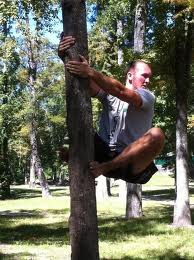PaleoFitness and MovNat
Much of the following is from an article titled “The Workout That Time Forgot” by Nick Heil in Outside Magazine, December 16th 2010:
 MovNat is founded on three “pillars” of movement: Natural, Evolutionary, and Situational. As such, it’s a system that aims to respect the environment, align with our biological heritage, and have practical application to real-world challenges.
MovNat is founded on three “pillars” of movement: Natural, Evolutionary, and Situational. As such, it’s a system that aims to respect the environment, align with our biological heritage, and have practical application to real-world challenges.
MovNat isn’t something that lends itself to strict, rigid programming. The whole point of natural movement is that it should be integrated into all of our physical activity.
Erwin Le Caorre is a movement coach, “MovNat is a comprehensive lifestyle,” Le Corre tells us. “It’s about diet and nutrition. It’s about exposure to sunlight and nature. It’s about getting rest. It’s about feeding the mind with healthy insights and positive thoughts.” Le Corre, who relocated to the United States full-time in 2009, founded MovNat on the premise that humans once dashed around untamed landscapes with power and grace, gathering berries, toppling mastodons, and so forth—and that proficiency at such things will help reconnect us to the world in which we evolved. Not only were we born to run, he says, but also to jump, climb trees, swim deep underwater, slog through swamps, stalk prey, and fight off attackers.
“We live like zoo animals!” It’s an idea Le Corre borrowed from the British zoologist Desmond Morris, author of the 1967 classic The Naked Ape, and it’s central to his worldview: that we are essentially wild creatures ill-suited to desk jobs and processed foods. “We have become divorced from nature, trapped in colorless boxes,” Le Corre says. “We have lost our adaptability, and it’s threatening our health and longevity.”
“Being fit isn’t about being able to lift a steel bar or finish an Ironman, it’s about rediscovering our biological nature and releasing the wild human animal inside.”
His coaching is seasoned with quasi-mystical declarations, like “Oxygen is an accident, breath is intentional,” and tips, like how listening to more reggae encourages rhythm and flow
“We’re less stressed when we see green, like leaves and grass.”
Exercising outdoors make us more resilient. MovNat views the body as a tool for dynamic movement, not a topiary sculpture.
Le Corre throws in some mind games, telling us we’re doing an exercise on a ten count but stopping at eight and then counting backwards or repeating a number over and over: “Seven, seven, seven, seven …”
“Do we function in sets of ten in the wilderness?” he asks. “How do we know how long we will have to do something?”
When jumping : “Cats are running the second they land,” he calls up as he loops back around. “If you do it the same way, you’ll decrease impact and be ready to flow into your next move.”
Le Corre is convinced that 20 to 30 minutes a day is all anyone needs for a killer workout, as long as it’s intelligently designed. By combining short, explosive bursts of running with lots of power work — jumps, climbs, and deadlifts — you can compress 2 hours of normal gym time into 20 minutes of constant motion.
Le Corre based MovNat heavily on the philosophy of French naval officer George Herbert. The modern world, Hebert believed, was producing hollow men who focused on appearance and forgot about function. At the same time, they stopped exercising with the wildness of kids and instead insulated themselves from risk. The cost, he felt, was far more destructive than they might think. Motivated to do what he could to realign our fitness philosophy, Hebert convinced the French navy to put him in charge of conditioning for a class of its recruits.
Next, Hebert set to work on an outdoor training facility. He designed it to look like a giant playground, equipping it with climbing towers, vaulting horses, sandpits, and ponds. Scattered about were rocks and logs and long poles to be used for throwing, or balancing, or passing hand-to-hand while running, or anything else an athlete dreamed up at the moment. Hebert had only one firm rule: No competing. When you try to beat the other guy, he believed, you test the other man’s weaknesses and not your own.
Within a few years, Hebert’s “Be Useful” system was adopted by the entire French navy. In 1913, speaking before the French Physical Education Congress, he astounded them with the results of tests he’d performed on 350 navy recruits. On a rating system that scored performance according to strength, speed, agility, and endurance, French sailors ranked with world-class decathletes.
Lee Saxby, P.T., a London-based physical therapist and the technical director of Wildfitness, an exercise program built around an evolutionary model of human performance. For years, Saxby had been teaching his clients that the key to overall health is a workout system that mimics the diversity of a hunter-gatherer lifestyle.







